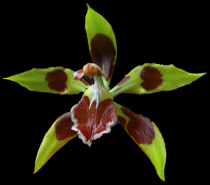International
Odontoglossum
Alliance
I

Enter
Type Species for the Genus
Odontoglossum epidendroides
Enter Text
CULTURE OF ODONTOGLOSSUMS
South America is the natural habitat for Odontoglossums where they grow in an area approximately 15 degrees either side of the Equator high in the Andes mountains at elevations between about 1,500 - 3,800 metres (5,000 ft and 12,500 ft). For most species night time temperatures are as low as 10° Celsius (50° Fahrenheit ) with constant high humidity, plentiful rainfall and heavy mists which help to compensate for higher temperatures during the daytime which reach the mid 24°C (70°F). Cool damp nights are essential for good growth. One size certainly does not fit all because many modern hybrids combine parents from related warmer growing genera, so it is useful to understand parentage before generalizing.
For further information refer to the list of Intergeneric Hybrids elsewhere on this site.
The following general cultivation principles are indicated:
Light - In their natural habitat Odontoglossums grow in filtered light beneath overhanging vegetation so although they need good light, they do not need direct sun. In fact, leaves burn easily so a balance of good general light is needed to stimulate growth and initiate flowering. Plants should be shaded during the Summer season while they are growing strongly then the light increased towards Autumn/Winter when pseudobulbs complete growth and ripen.
Temperature - A good diurnal fluctuation in temperature mimicks their natural habitat improving plant vigour and extending flower life. 10-13°C (50-55°F) is ideal for nights but the plants need an increase of +/-11°C (+/- 20°F) during Spring/Summer days which can reduce to just an additional +/-6°C (+/-10°F) during Autumn/Winter days.
Watering - While Odontoglossums do not require a formal dry season, they need less water during Winter months. Composts should never dry completely so watering will depend upon individual conditions, probably every 5-7 days during Spring/Summer reducing to every 7-10 days in Autumn/Winter when reduced light and less warmth slow their growth. A buoyant humid atmosphere is needed (60%) throughout the year with an ideal minimum of 50%. Overhead misting is beneficial particularly in the evening and early morning during Summer months to mirror the natural cloud mist cycle. Care should be taken to maintain humidity during colder months when heaters can dry the atmosphere.
Fertiliser - Orchids generally are light feeding plants but as Odontoglossums grow throughout the year a constant supply of weak nutrients is beneficial. Every grower will have their own regimen for feeding, but the principle of a “growth” formula (e.g. N20:P5:K15) during Spring/Summer followed in Autumn/Winter by a “flower promoting” formula (e.g. N15:P5:K20) works well. Feed is administered to roots through the watering system although an occasional folia feed can be a beneficial tonic.
Air movement - Odontoglossums and their hybrids need constant air movement reflecting the freshness of their natural habitat. These plants will not thrive in stale or stagnant air so throughput of as much fresh air as possible is essential for successful culture - continuously operating fans are very beneficial.
Potting - The ideal time to pot Odontoglossums is while new growths are still quite small, about 3 inches high, when young roots are still emerging. This usually occurs in early Spring or early Autumn. Odontoglossums like to be snug in their pots so never over pot,, just leaving enough room for a maximum of the next two growths is sufficient. Make sure the compost is free draining, will retain moisture without being wet and also allows air to reach the roots.